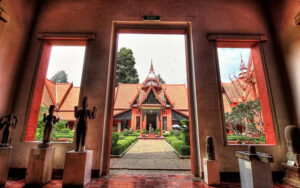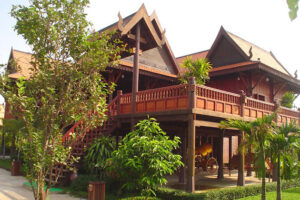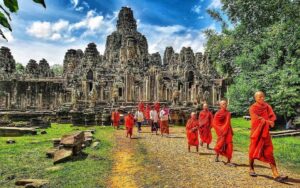Architecture & Housing
Khmer architecture (Khmer: ស្ថាបត្យកម្មខ្មែរ), also known as Angkorian architecture (Khmer: ស្ថាបត្យកម្មសម័យអង្គរ), is the architecture produced by the Khmers during the Angkor period of the Khmer Empire from approximately the later half of the 8th century CE to the first half of the 15th century CE.
The architecture of the Indian rock-cut temples, particularly in sculpture, had an influence on Southeast Asia and was widely adopted into the Indianised architecture of Cambodian (Khmer), Annamese and Javanese temples (of the Greater India). [1][2] Evolved from Indian influences, Khmer architecture became clearly distinct from that of the Indian sub-continent as it developed its own special characteristics, some of which were created independently and others of which were incorporated from neighboring cultural traditions, resulting in a new artistic style in Asian architecture unique to the Angkorian tradition.[3] The development of Khmer architecture as a distinct style is particularly evident in artistic depictions of divine and royal figures with facial features representative of the local Khmer population, including rounder faces, broader brows, and other physical characteristics.[4] In any study of Angkorian architecture, the emphasis is necessarily on religious architecture, since all the remaining Angkorian buildings are religious in nature. During the period of Angkor, only temples and other religious buildings were constructed of stone.
 Non-religious buildings such as dwellings were constructed of perishable materials such as wood, and so have not survived. The religious architecture of Angkor has characteristic structures, elements, and motifs, which are identified in the glossary below. Since a number of different architectural styles succeeded one another during the Angkorean period, not all of these features were equally in evidence throughout the period. Indeed, scholars have referred to the presence or absence of such features as one source of evidence for dating the remains.
Non-religious buildings such as dwellings were constructed of perishable materials such as wood, and so have not survived. The religious architecture of Angkor has characteristic structures, elements, and motifs, which are identified in the glossary below. Since a number of different architectural styles succeeded one another during the Angkorean period, not all of these features were equally in evidence throughout the period. Indeed, scholars have referred to the presence or absence of such features as one source of evidence for dating the remains.
Many temples had been built before Cambodia became a powerful Kingdom of Khmer Empire which dominated most of the Indochina region. At that time, Cambodia was known as Chenla kingdom, the predecessor state of the Khmer empire. There are three pre-Angkorean architectural styles:[5]
- Sambor Prei Kukstyle (610–650): Sambor Prei Kuk, also known as Isanapura, was the capital of the Chenla Kingdom. Temples of Sambor Prei Kuk were built in rounded, plain colonettes with capitals that include a bulb.
- Prei Khmengstyle (635–700): Structures reveal masterpieces of sculpture but examples are scarce. Colonettes are larger than those of previous styles. Buildings were more heavily decorated but had general decline in standards.
- Kompong Preahstyle (700–800): Temples with more decorative rings on colonettes which remain cylindrical. Brick constructions were being continued.
 Scholars have worked to develop a periodization of Angkorean architectural styles. The following periods and styles may be distinguished. Each is named for a particular temple regarded as paradigmatic for the style.[6]
Scholars have worked to develop a periodization of Angkorean architectural styles. The following periods and styles may be distinguished. Each is named for a particular temple regarded as paradigmatic for the style.[6]
- Kulenstyle (825–875): Continuation of pre-Angkorean style but it was a period of innovation and borrowing such as from Cham temples. Tower is mainly square and relatively high as well as brick with laterite walls and stone door surrounds but square and octagonal colonettes begin to appear.
- Preah Kostyle (877–886): Hariharalaya was the first capital city of the Khmer empire located in the area of Angkor; its ruins are in the area now called Roluos some fifteen kilometers southeast of the modern city of Siem Reap. The earliest surviving temple of Hariharalaya is Preah Ko; the others are Bakong and Lolei. The temples of the Preah Ko style are known for their small brick towers and for the great beauty and delicacy of their lintels.
- BakhengStyle (889–923): Bakheng was the first temple mountain constructed in the area of Angkor proper north of Siem Reap. It was the state temple of King Yasovarman, who built his capital of Yasodharapura around it. Located on a hill (phnom), it is currently one of the most endangered of the monuments, having become a favorite perch for tourists eager to witness a glorious sundown at Angkor.
- Koh KerStyle (921–944): During the reign of King Jayavarman IV, capital of Khmer empire was removed from Angkor region through the north which is called Koh Ker. The architectural style of temples in Koh Ker, scale of buildings diminishes toward center. Brick still main material but sandstone also used.
- Pre RupStyle (944–968): Under King Rajendravarman, the Angkorian Khmer built the temples of Pre Rup, East Mebon and Phimeanakas. Their common style is named after the state temple mountain of Pre Rup.
- Banteay SreiStyle (967–1000): Banteay Srei is the only major Angkorian temple constructed not by a monarch, but by a courtier. It is known for its small scale and the extreme refinement of its decorative carvings, including several famous narrative bas-reliefs dealing with scenes from Indian mythology.
- KhleangStyle (968–1010): The Khleang temples, first use of galleries. Cruciform gopuras. Octagonal colonettes. Restrained decorative carving. A few temples that were built in this style are Ta Keo, Phimeanakas.
- BaphuonStyle (1050–1080): Baphuon, the massive temple mountain of King Udayadityavarman II was apparently the temple that most impressed the Chinese traveller Zhou Daguan, who visited Angkor toward the end of the 13th century. Its unique relief carvings have a naive dynamic quality that contrast with the rigidity of the figures typical of some other periods. As of 2008, Baphuon is under restoration and cannot currently be appreciated in its full magnificence.
- Classical or Angkor WatStyle (1080–1175): Angkor Wat, the temple and perhaps the mausoleum of King Suryavarman II, is the greatest of the Angkorian temples and defines what has come to be known as the classical style of Angkorian architecture. Other temples in this style are Banteay Samre and Thommanon in the area of Angkor, and Phimai in modern Thailand.
- BayonStyle (1181–1243): In the final quarter of the 12th century, King Jayavarman VII freed the country of Angkor from occupation by an invasionary force from Champa. Thereafter, he began a massive program of monumental construction, paradigmatic for which was the state temple called the Bayon. The king’s other foundations participated in the style of the Bayon, and included Ta Prohm, Preah Khan, Angkor Thom, and Banteay Chmar. Though grandiose in plan and elaborately decorated, the temples exhibit a hurriedness of construction that contrasts with the perfection of Angkor Wat.
- Post BayonStyle (1243–1431): Following the period of frantic construction under Jayavarman VII, Angkorian architecture entered the period of its decline. The 13th century Terrace of the Leper King is known for its dynamic relief sculptures of demon kings, dancers, and nāgas.
Angkorian builders used brick, sandstone, laterite and wood as their materials. The ruins that remain are of brick, sandstone and laterite, the wood elements having been lost to decay and other destructive processes.
Brick
 The earliest Angkorian temples were made mainly of brick. Good examples are the temple towers of Preah Ko, Lolei and Bakong at Hariharalaya. Decorations were usually carved into a stucco applied to the brick, rather than into the brick itself.[7] This was because bricks were a softer material, and did not lend themselves to sculpting, as opposed to stones of different kinds such as the Sandstones or the Granites. However, the tenets of the Sacred Architecture as enunciated in the Vedas and the Shastras, require no adhesives to be used while building blocks are assembled one over the other to create the Temples, as such bricks have been used only in relatively smaller temples such as Lolei and The Preah Ko. Besides, strength of bricks is much lesser as compared to the stones (mentioned here-in) and the former degrade with age.
The earliest Angkorian temples were made mainly of brick. Good examples are the temple towers of Preah Ko, Lolei and Bakong at Hariharalaya. Decorations were usually carved into a stucco applied to the brick, rather than into the brick itself.[7] This was because bricks were a softer material, and did not lend themselves to sculpting, as opposed to stones of different kinds such as the Sandstones or the Granites. However, the tenets of the Sacred Architecture as enunciated in the Vedas and the Shastras, require no adhesives to be used while building blocks are assembled one over the other to create the Temples, as such bricks have been used only in relatively smaller temples such as Lolei and The Preah Ko. Besides, strength of bricks is much lesser as compared to the stones (mentioned here-in) and the former degrade with age.
Angkor’s neighbor state of Champa was also the home to numerous brick temples that are similar in style to those of Angkor. The most extensive ruins are at Mỹ Sơn in Vietnam. A Cham story tells of the time that the two countries settled an armed conflict by means of a tower-building contest proposed by the Cham King Po Klaung Garai. While the Khmer built a standard brick tower, Po Klaung Garai directed his people to build an impressive replica of paper and wood. In the end, the Cham replica was more impressive than the real brick tower of the Khmer, and the Cham won the contest.[8]
Sandstone
The only stone used by Angkorian builders was sandstone, obtained from the Kulen mountains. Since its obtainment was considerably more expensive than that of brick, sandstone only gradually came into use, and at first was used for particular elements such as door frames. The 10th-century temple of Ta Keo is the first Angkorian temple to be constructed more or less entirely from Sandstone.
Laterite
Angkorian builders used laterite, a clay that is soft when taken from the ground but that hardens when exposed to the sun, for foundations and other hidden parts of buildings. Because the surface of laterite is uneven, it was not suitable for decorative carvings, unless first dressed with stucco. Laterite was more commonly used in the Khmer provinces than at Angkor itself.[10] Because the water table in this entire region is well high, Laterite has been used in the underlying layers of Angkor Wat and other temples (especially the larger ones), because it can absorb water and help towards better stability of the Temple.
Sapa Sunshine Travel
We bring an interesting and safe trip to customers, tourist services play an important role in the journey. We ensure that we will provide you with a high quality service to make your trip more and more comfortable and memorable.
Custom Links
*Home
*Sapa Tours
*All Tours
*Services
*Where To Travel
*Travel Services
Contact Us
- Sapa Town, Lao Cai, Vietnam
- +84968812644
- info@sapasunshinetravel.com
- www.sapasunshinetravel.com
- www.sapasunshinetravel.com.vn
Copyrights 2021 – All rights reserved
- ←
-
Email Us
Please send us an Email
- Facebook Messenger
